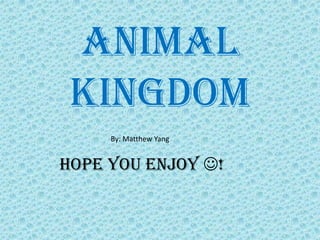
Animal info
- 1. Animal kingdom By: Matthew Yang Hope you enjoy !
- 2. Vertebrates • Mammals • Birds • Amphibian • Fish • Reptile All vertebrates have backbones
- 3. Mammals • Drink milk from mother • Have fur or hair • Breath oxygen from lungs • Warm blooded • Young are born alive
- 4. Birds • Have feather • Most can fly • Lay eggs • Warm blooded • Have beaks
- 5. Amphibians • Two life, one life in water and one life on land • Cold blooded • Lay eggs • Smooth, moist skin
- 6. Fish • Have gills • Have fins • Lay eggs • Have scales • Live in water • Cold blood
- 7. Reptile • Have scales • Lay eggs • Breath with lungs • Cold blooded • Four or no legs • Dry skin
- 8. Invertebrates • Arthropods • Mollusk • Worms • Simple bodied Invertebrates do not have backbones
- 9. Arthropods • Largest group of invertebrates • Insect • Arachnid • Have exoskeleton
- 10. Arachnids • Spiders • Have eight legs • Have jointed legs • Over 100,000 species
- 11. Insect • Have six legs • Have a head ,thorax, and abdomen • Exoskeleton • Two antennae • Some have wingS and Some don’t
- 12. Mollusk • Soft body • Hard shell • Muscular foot • Rough tongue
- 13. Worms • get inSide people’S body • Tape worms • Sections • Some are flat
- 14. Simple Bodied • Sponges • Flatworms • Roundworms • Jelly fish
- 15. Animal needs • Water • Shelter • Food • Warmth • Oxygen
- 16. Adaptation • Talons • Blubber • Camouflage • Long Legs • Beaks • Jaws • Fangs